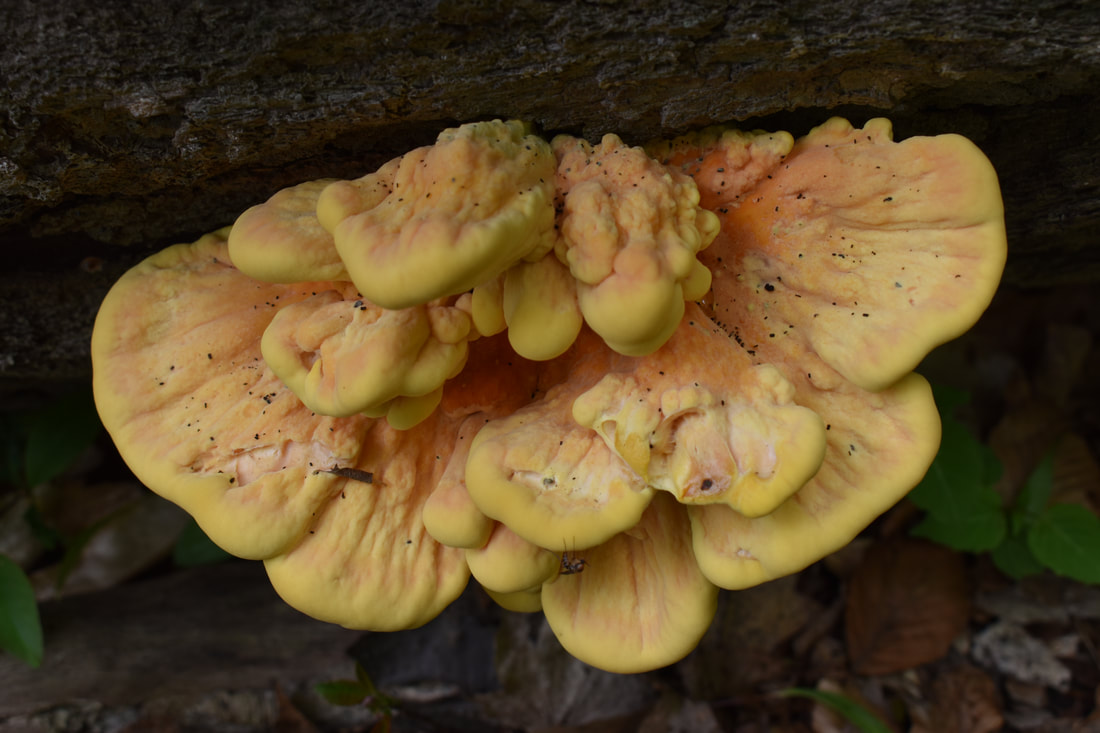|
MycoBank Taxonomy: Fungi, Dikarya, Basidiomycota, Agaricomycotina, Agaricomycetes, Polyporales, Fomitopsidaceae, Laetiporus Laetiporus sulphureus is a magnificent mushroom, easily identifiable by its bright yellow pore surface and overlapping, shelf-like growth on the standing or fallen trunks of hardwoods. It might just be my all-time favorite mushroom. The young mushrooms check all the boxes of a great wild edible:
That's right, if you find a mega flush, there will likely be more chicken than you can eat yourself and others will be eager to buy it from you. In Ann Arbor, chicken of the woods fetches about $16 a pound. The flush documented here, which I found when the mushrooms were just starting to bubble out of a large downed trunk, yielded about 50 pounds of tender chicken over the span of a week. Unless you find chicken of the woods when it is nothing more than an extremely young marshmallow, it is best to harvest right away. The pictures above show chicken of the woods in its ideal state: not at all tough, but also enlarged into substantially sized fruiting bodies. The picture below shows the mushrooms later in the week, still good to eat but already diminished in quality. If I had left them for a later, even larger harvest, they would have lost their sublime texture and become a just-so-so mushroom, or even too tough to really enjoy. Chicken of the woods will persist through the year, becoming increasingly unrecognizable, until it is nothing more than a hard, brittle, bleached, soggy piece of sytrofoam. If you find these old chickens, note the location so that you can return later for fresh ones. I transformed this royal harvest into five meals. First, I made a wild mushroom coconut curry recipe from Madhur Jaffrey's Vegetarian India: creamy, succulent mushrooms, explosive flavor, delicious. Next, I made beer-battered chicken of the woods tenders and a potato hash. The hash was tasty, a bit dry though; the deep-fried tenders slayed me. I also grilled some fronds and ate them on tempeh slathered with Frank's RedHot sauce, which was enough to satisfy anybody's craving for a spicy chicken sandwich. There is no shortage of creative and delicious preparations for chicken of the woods – recipes abound on the internet. Laetiporus sulphureus is one of six species of Laetiporus that grow in North America. Laetiporus cincinnatus is another excellent edible that looks similar except it has a white pore surface and grows from the base of trees or from the ground (as a butt rot fungus, as opposed to Laetiporus sulphureus, which is a heart rotting species). According to Michael Kuo, there is a rare variety of Laetiporus sulphureus with a white pore surface, so the combination of pore color and ecology are necessary to separate the two species. Laetiporus huroniensis, which I've never found, grows on conifers east of the Rockies. West of the Rockies, one can find Laetiporus conifericola. Down south in the states bordering the Gulf of Mexico and in the Caribbean, Laetioporus gilbertsonii and Laetiporus persicinus are present. A word of caution: when you read that you should try a little bit of a mushroom the first time you eat it, even when it is a well regarded edible, that's largely because of chicken of the woods. Apparently this species is more responsible than most for allergic reactions. However, it seems like allergic reactions are still relatively rare and don't seem to get too much worse than tingly lips. Folks at MSU Extension say that it might be a matter of substrate – conifers and locusts being the culprits – which would suggest that Laetiporus huroniensis is actually the principal offender. SpecimenACD0289, iNaturalist #47428074; 23 May 2020; Washtenaw Co., MI, USA; leg. Alden C. Dirks, det. Alden C. Dirks; GenBank #MZ919222 (ITS rDNA), MICH 352252. Online Resources
2 Comments
maricel
7/27/2020 01:19:41 pm
Muchas gracias por tan completa lección. Tu lenguage es tan exquisito así como tus fotos. Gracias por compartir. Tus comidas se ven muy apetitosas!
Reply
Alden
7/29/2020 07:08:16 am
Gracias Maricel :) Sos tan amable!
Reply
Your comment will be posted after it is approved.
Leave a Reply. |
PermalinksProject Introduction Top EdiblesHericium coralloides
Laetiporus sulphureus Morchella americana Polyporus umbellatus Suillus ampliporus Archives
April 2023
Categories |
|
|
Terms of Use, Liability Waiver, and Licensing
The material on aldendirks.com is presented for general informational and educational purposes only, and under no circumstances is to be considered a substitute for identification of an actual biological specimen by a person qualified to make that judgment. Some fungi are poisonous; please be cautious. All images on this website are licensed under Attribution-NonCommercial-NoDerivatives 4.0 International (CC BY-NC-ND 4.0). |



 RSS Feed
RSS Feed




